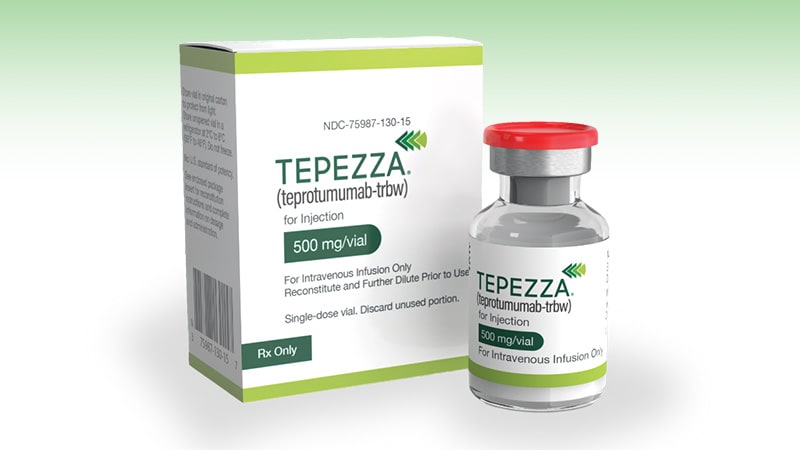NEW ORLEANS — Teprotumumab (Tepezza) works equally well in both older and younger patients with thyroid eye disease (TED) and regardless of TED duration, new data suggest.
TED is an autoimmune disease characterized by orbital inflammation and expansion of fat and muscles around the eyes, resulting in proptosis, diplopia, pain, redness, and swelling. Many of the patients have Graves disease.
In patients aged < 40 years, TED typically lacks restrictive myopathy, involves orbital fat expansion and proptosis with minimal to no periorbital inflammation or diplopia, and has low rates of dysthyroid optic neuropathy (type 1 disease). In contrast, in patients aged 40 years or older, TED often involves restrictive myopathy, along with extraocular muscle (EOM) enlargement and fibrosis, diplopia, and periorbital inflammation, and higher rates of dysthyroid optic neuropathy (type 2 disease).
A small study published in 2023 suggested that teprotumumab worked better at reducing EOM size in older vs younger patients, although both groups experienced significant reductions in EOM. Now, the new data suggest no differences by disease duration or age, said Shoaib Ugradar, MD, an ophthalmologist in private practice in Beverly Hills, California. He presented the data on May 9, 2024, at the annual meeting of the American Association of Clinical Endocrinology.
“In patients proposed to have type 1 and type 2 TED based on an age cutoff of 40 years who were treated with teprotumumab, comparable improvements were observed in proptosis, diplopia, clinical activity score, and Graves’ Ophthalmopathy Quality of Life (GO-QOL) scores. Results were consistent in patients with acute TED and those with longer-duration TED with clinical activity score at or below 1,” Ugradar said.
Asked to comment, session moderator Thanh D. Hoang, DO, director of the endocrinology division at the Uniformed Services University of the Health Sciences, Bethesda, Maryland, told Medscape Medical News that the data align with his experience using teprotumumab to treat TED. “It works very well for a lot of my patients, some of them acute. But also some who have had it 10 or more years will also respond well to the medication.”
Hoang, who is also Consultant Endocrinologist to the United States Capitol Attending Physician, also said that since its US approval in 2020, the drug has made a major difference in the treatment of TED.
“I like this medication a lot because 15 or 20 years ago, patients often had to undergo orbital decompression surgery to help with worsening eye symptoms or we would have to give them a lot of steroids, which decrease the inflammation but of course have side effects. And as soon as you stop the steroids, the symptoms would recur.”
Hoang noted that a small percentage of patients have recurrences or are nonresponders, and he is currently studying the genetic loci associated with those individuals.
He also noted that he is seeing fewer side effects today, including hearing loss, hyperglycemia, and muscle aches and/or cramps, than when the drug first came out, but even when those do occur, “the benefits outweigh the risks.”
No Differences in Teprotumumab Response by Age
The study was a post hoc analysis of pooled data from teprotumumab-treated patients in clinical trials. In a randomized phase 2 trial, patients received a total of eight infusions of the drug or placebo once every 3 weeks. A total of 121 patients had acute TED with a duration of 9 months or less and a Clinical Activity Score (CAS) of 4 or more. Another 42 patients had TED duration between 2 and 10 years and CAS of 1 or less.
Among those with acute TED, there were no significant differences at week 24 between those younger than 40 and those aged 40 or older who had responses in terms of proptosis (≥ 2 mm improvement) (86.4% vs 79.8%, respectively; P = .602), diplopia (73.3% vs 66.2%; P = .619), and CAS (76.2% vs 60.0%; P = .71). Overall response was 81.0% vs 73.7%, also not significantly different between the groups (P = .535).
Proptosis was reduced in the acute TED group by 3.46 mm in persons younger than 40 years and by 3.22 mm among those aged 40 or older, but this difference was not significant (P = .525). Total GO-QOL scores improved similarly in both groups (P = .446).
Among the patients with longer-duration TED, proptosis scores were reduced by 2.0 mm in the younger group vs 2.6 mm in the older group (P = .275). Response rates for proptosis were 61.5% and 62.1%, respectively, and 50.0% vs 40.0% for diplopia (both P = 1.0). GO-QOL scores also did not differ significantly by age.
The study was funded by Amgen. Ugradar is a consultant for Acelyrin and Amgen (formerly Horizon Therapeutics). Hoang has no disclosures.
Miriam E. Tucker is a freelance journalist based in the Washington DC area. She is a regular contributor to Medscape, with other work appearing in the Washington Post, NPR’s Shots blog, and Diatribe. She is on X (formerly Twitter) @MiriamETucker.
